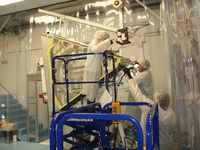Difference between revisions of "PhysWebPageBannerContent"
| Line 1: | Line 1: | ||
=Physics Department Mission /overview= | =Physics Department Mission /overview= | ||
| + | |||
| + | Our mission: | ||
| + | The mission of the Idaho State University Department of Physics is to | ||
| + | pursue cutting edge research in both fundamental and applied physics, | ||
| + | and train of the next generation of physical scientists, technicians, and | ||
| + | educators. | ||
| + | |||
| + | ;Overview: | ||
| + | |||
| + | The Idaho State University Department of Physics is actively engaged in a | ||
| + | variety of cutting edge research pursuits, all of which focus on the use of experimental | ||
| + | nuclear physics techniques to address problems in both fundamental and applied | ||
| + | science. Major efforts include: | ||
| + | *nuclear non-proliferation and homeland security | ||
| + | *radiation effects in materials and devices | ||
| + | *nuclear reactor fuel cycle physics | ||
| + | *accelerator applications | ||
| + | *biology | ||
| + | *fundamental nuclear and particle physics. | ||
=Clean Room= | =Clean Room= | ||
Revision as of 23:15, 26 November 2014
Physics Department Mission /overview
Our mission: The mission of the Idaho State University Department of Physics is to pursue cutting edge research in both fundamental and applied physics, and train of the next generation of physical scientists, technicians, and educators.
- Overview
The Idaho State University Department of Physics is actively engaged in a variety of cutting edge research pursuits, all of which focus on the use of experimental nuclear physics techniques to address problems in both fundamental and applied science. Major efforts include:
- nuclear non-proliferation and homeland security
- radiation effects in materials and devices
- nuclear reactor fuel cycle physics
- accelerator applications
- biology
- fundamental nuclear and particle physics.
Clean Room
The Idaho Accelerator Center and ISU's Department of Physics are building detectors for an upgrade of Jefferson Lab's Hall B. The detectors are wire chambers containing approximately 5,000, 30 micron diameter wires that are used to form gaseous cells which can detect the passage of ionizing particles. The 2 year long project will construct detectors that are about 6 feet high and will eventually be installed at Jefferson Lab in Newport News, Va. The detectors will be part of a larger detector that will be used by a group of more than 100 physicists to perform fundamental nuclear physics measurements.
